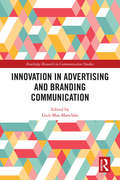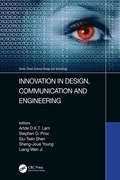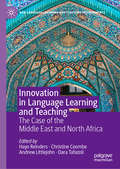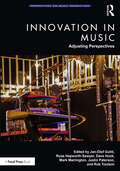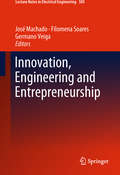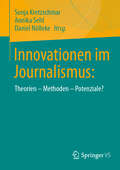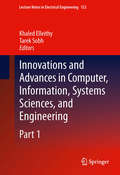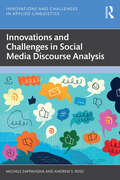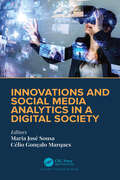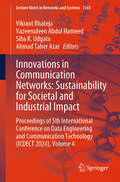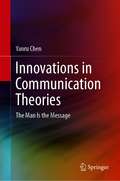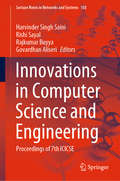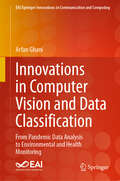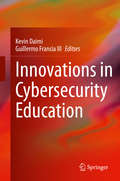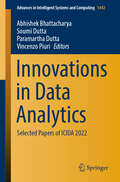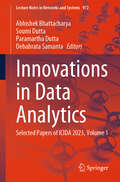- Table View
- List View
Innovation in Branding and Advertising Communication (Routledge Research in Communication Studies)
by Lluís Mas-ManchónThis book addresses innovative and new aspects of branding and advertising communication, by drawing on a broad, interdisciplinary range of theories, methods and techniques– from body image, identity and mental imagery, to self-exposure and LCM4P – intersecting with branding and advertising constructs and practices. The editor combines the perspectives of an international group of scholars to establish new theoretical frameworks and proposes new methodological designs to conduct comprehensive studies in the field. Situated at the intersection between society, communication and psychology, each chapter presents an innovative approach to branding and advertising research. The book explores topics such as social robots, body image in video advertising, brand personality, transmedia personal brands, erotic content in commercial images, and brand fandom communities. Innovation in Advertising and Branding Communication will be a valuable resource for scholars working in the fields of marketing communication, branding and advertising, online communication, sociology, social psychology and linguistics
Innovation in Design, Communication and Engineering: Proceedings of the 8th Asian Conference on Innovation, Communication and Engineering (ACICE 2019), October 25-30, 2019, Zhengzhou, P.R. China (Smart Science, Design & Technology)
by Stephen D. Prior Artde Donald Kin-Tak Lam Siu-Tsen Shen Sheng-Joue Young Liang-Wen JiThis volume represents the proceedings of the 8th Asian Conference on Innovation, Communication and Engineering (ACICE 2019), which was held in P.R. China, October 25-30, 2019. The conference aimed to provide an integrated communication platform for researchers in a wide range of fields including information technology, communication science, applied mathematics, computer science, advanced material science, and engineering. The conference and resulting proceedings aim to enhance interdisciplinary collaborations between science and engineering technologists in academia and industry within this unique international network.
Innovation in Electrical Power Engineering, Communication, and Computing Technology: Proceedings of IEPCCT 2019 (Lecture Notes in Electrical Engineering #630)
by Janmenjoy Nayak Bighnaraj Naik Danilo Pelusi Renu Sharma Manohar MishraThis book features selected high-quality papers from the International Conference on Innovation in Electrical Power Engineering, Communication, and Computing Technology (IEPCCT 2019), held at Siksha 'O' Anusandhan (Deemed to be University), Bhubaneswar, India, on 13–14 December 2019. Presenting innovations in power, communication, and computing, it covers topics such as mini, micro, smart and future power grids; power system economics; energy storage systems; intelligent control; power converters; improving power quality; signal processing; sensors and actuators; image/video processing; high-performance data mining algorithms; advances in deep learning; and optimization methods.
Innovation in Language Learning and Teaching: The Case of the Middle East and North Africa (New Language Learning and Teaching Environments)
by Christine Coombe Hayo Reinders Andrew Littlejohn Dara TafazoliThis edited collection presents a study of innovation in teaching, learning, assessment and teacher development practices in the Middle East and North Africa (MENA). The thirteen research-based chapters in this collection examine recent innovations in English language teaching, drawing on classroom, administrative and learning experiences from seven of the countries in the region. The major trends analyzed across the volume include the language skills of reading and writing and the prevalence of technology and technology-enhanced instruction. It highlights that innovative teaching, learning and assessment practices that are now in place in virtually all levels of English language teaching and learning from primary school to university to adult education sectors, and reflects on possible ways forward for innovation in the field of ELT. This book will provide valuable insight for scholars of applied linguistics and practitioners working in language policy,
Innovation in Language Learning and Teaching: The Case of the Southern Caribbean (New Language Learning and Teaching Environments)
by Hayo Reinders Diego Mideros Nicole Roberts Beverly-Anne CarterThis book presents a unique perspective from an underrepresented region in the Global South. The volume features four different countries in the region: Barbados, Guyana, St. Lucia, and Trinidad and Tobago, as well as Martinique, an island located just north of St. Lucia which is an overseas region of France. It documents innovations in learning and teaching Spanish, French, and Chinese in the case of the English-speaking countries, and English as a foreign language (EFL) in the case of Martinique. The chapters cover different aspects of language education in the Caribbean and will be of particular interest to those involved in managing change in language education that attempts to mediate between global trends and local needs.
Innovation in Music: Adjusting Perspectives (Perspectives on Music Production)
by Russ Hepworth-Sawyer Mark Marrington Justin Paterson Rob Toulson Jan-Olof Gullö Dave HookInnovation in Music: Adjusting Perspectives brings together cutting-edge research on new innovations in the field of music production, technology, performance, and business. With contributions from a host of well-respected researchers and practitioners, this volume provides crucial coverage on the relationship between innovation and rebellion.Including chapters on generative AI, gender equality, live music, quantisation, and composition, this book is recommended reading for music industry researchers working in a range of fields, as well as professionals interested in industry innovations.
Innovation, Engineering and Entrepreneurship (Lecture Notes in Electrical Engineering #505)
by Filomena Soares José Machado Germano VeigaThis book presents endeavors to join synergies in order to create added value for society, using the latest scientific knowledge to boost technology transfer from academia to industry. It potentiates the foundations for the creation of knowledge- and entrepreneurial cooperation networks involving engineering, innovation, and entrepreneurship stakeholders. The Regional HELIX 2018 conference was organized at the University of Minho’s School of Engineering by the MEtRICs and Algoritmi Research Centers, and took place in Guimarães, Portugal, from June 27th to 29th, 2018. After a rigorous peer-review process, 160 were accepted for publication, covering a wide range of topics, including Control, Automation and Robotics; Mechatronics Design, Medical Devices and Wellbeing; Cyber-Physical Systems, IoT and Industry 4.0; Innovations in Industrial Context and Advanced Manufacturing; New Trends in Mechanical Systems Development; Advanced Materials and Innovative Applications; Waste to Energy and Sustainable Environment; Operational Research and Industrial Mathematics; Innovation and Collaborative Arrangements; Entrepreneurship and Internationalization; and Oriented Education for Innovation, Engineering and/or Entrepreneurship.
Innovationen im Journalismus: Theorien – Methoden – Potenziale?
by Annika Sehl Sonja Kretzschmar Daniel NöllekeDer Wandel von Journalismus und Medien ist eine Konstante im digitalen Zeitalter. Dieser Wandel betrifft die Mikro- und Meso- ebenso wie die Makroebene. Neue Akteure sind hinzugekommen, tradierte Geschäftsmodelle von Medienunternehmen ins Wanken geraten und die Plattformisierung wirft neue Fragen nach Gemeinwohl auf. Wie können Medienorganisationen die Herausforderungen meistern und einen qualitativ hochwertigen Journalismus sicherstellen? Was kann die Journalismusforschung leisten? Dieser Sammelband verfolgt das Ziel, das breite Spektrum von Innovationen in Journalismus und Medien wissenschaftlich einzuordnen und zu strukturieren. Dabei werden sowohl theoretische Annäherungen, als auch praxisnahe Umsetzungsformen diskutiert. Der Sammelband geht auf eine Tagung der DGPuK-Fachgruppe Journalistik/Journalismusforschug zum selbigen Thema zurück.
Innovationen und Innovationspotenziale im öffentlich-rechtlichen Medienjournalismus (BestMasters)
by Steffen GrütjenDer Medienjournalismus als fachjournalistische Disziplin ist landläufig mit einem Nischenstempel behaftet. Seit seinen Anfängen als klassische Medienseite in (überregionalen) Tageszeitungen hat er sich stark ausdifferenziert und tritt mit neuen Angebotsformen inzwischen verstärkt im Social Web auf. Die Forschungsarbeit systematisiert und reflektiert erstmals Innovationsstrukturen im öffentlich-rechtlichen Medienjournalismus. In Leitfadeninterviews gewähren Medienjournalist*innen von ARD und Deutschlandradio Einblicke in ihre (innovative) Programmgestaltung und formateigenen Zielgruppenvorstellungen. Als Forschungsgegenstand werden neun genuine Medienmagazine betrachtet, darunter „ZAPP“ (Norddeutscher Rundfunk), „@mediasres“ (Deutschlandfunk) oder „Töne, Texte, Bilder“ (Westdeutscher Rundfunk). Mit Blick auf den öffentlich-rechtlichen Auftrag messen die Befragten dem Medienjournalismus in öffentlich-rechtlicher Verantwortung eine große Bedeutung bei – sowohl im Lichte einer kritischenBegleitung von journalismus- bzw. medienspezifischen Themen und Spannungsfeldern als auch bei der Wandelbarkeit von tradierten Programmmustern.
Innovations and Advances in Computer, Information, Systems Sciences, and Engineering
by Khaled Elleithy Tarek SobhInnovations and Advances in Computer, Information, Systems Sciences, and Engineering includes the proceedings of the International Joint Conferences on Computer, Information, and Systems Sciences, and Engineering (CISSE 2011). The contents of this book are a set of rigorously reviewed, world-class manuscripts addressing and detailing state-of-the-art research projects in the areas of Industrial Electronics, Technology and Automation, Telecommunications and Networking, Systems, Computing Sciences and Software Engineering, Engineering Education, Instructional Technology, Assessment, and E-learning.
Innovations and Challenges in Social Media Discourse Analysis (Innovations and Challenges in Applied Linguistics)
by Michele Zappavigna Andrew S. RossInnovations and Challenges in Social Media Discourse Analysis provides a key introduction to the analysis of everyday discourse on social media platforms.Outlining the challenges involved in the study of social media discourse that includes social interaction, relationality, intersubjectivity, and intermodality, this book takes a social semiotic approach to offer a useful reconceptualisation of existing tools and introduces new methodologies to help those studying in this area.Drawing on a range of corpora that feature tweets, Instagram photos, YouTube comments, and emoji, this book is essential reading for students studying modules on discourse analysis and language and media.
Innovations and Social Media Analytics in a Digital Society
by Maria José Sousa and Célio Gonçalo MarquesRecent advances in digitization are transforming healthcare, education, tourism, information technology, and some other sectors. Social media analytics are tools that can be used to measure innovation and the relation of the companies with the citizens. This book comprises state-ofthe-art social media analytics, and advanced innovation policies in the digitization of society. The number of applications that can be used to create and analyze social media analytics generates large amounts of data called big data, including measures of the use of the technologies to develop or to use new services to improve the quality of life of the citizens. Digitization has applications in fields from remote monitoring to smart sensors and other devices. Integration generates data that need to be analyzed and visualized in an easy and clear way, that will be some of the proposals of the researchers present in this book. This volume offers valuable insights to researchers on how to design innovative digital analytics systems and how to improve information delivery remotely.
Innovations in Communication Networks: Proceedings of 5th International Conference on Data Engineering and Communication Technology (ICDECT 2024), Volume 4 (Lecture Notes in Networks and Systems #1365)
by Ahmad Taher Azar Vikrant Bhateja Siba K. Udgata Vazeerudeen Abdul HameedThis book includes selected papers presented at the 5th International Conference on Data Engineering and Communication Technology (ICDECT 2024), held at Asia Pacific University of Technology and Innovation (APU, Kuala Lumpur, Malaysia, during 28–29 September 2024. It features advanced, multidisciplinary research towards the design of smart computing, information systems and electronic systems. It also focuses on various innovation paradigms in system knowledge, intelligence and sustainability which can be applied to provide viable solutions to diverse problems related to society, the environment and industry.
Innovations in Communication Theories: The Man Is the Message
by Yanru ChenThis book offers a novel approach to innovations in theories of communication and social development. It proposes that "the man is the message". It argues that communication is woven into the fabric of people’s daily lives, and a scholar with a keen eye, an open heart and an inquiring mind should be able to capture the ubiquitous phenomena of communication and turn them into theoretical observations and even innovations.Although most of the propositions in this book cannot be tested empirically, at least for now, owing to the limitations inherent in current research methods, they complement the empirical studies of communication based on measurement.With due understanding that Western social sciences, including communication studies, focus on analytical thinking and the fine division of disciplines, this book takes a more synthetic approach to analyzing communication, often integrating and contextualizing its various factors and channels and categories in analysis and writing. Providing a holistic picture of communication that features the crux of the matter—how to reach and capture the heart and soul of people without any attempt to manipulate their minds, it is more humanistic than many other books on communication studies. Although much of the thinking in the book is seemingly Chinese, it nevertheless has a universal appeal.
Innovations in Computer Science and Engineering: Proceedings of 7th ICICSE (Lecture Notes in Networks and Systems #103)
by Rajkumar Buyya Rishi Sayal Harvinder Singh Saini Govardhan AliseriThis book features a collection of high-quality, peer-reviewed research papers presented at the 7th International Conference on Innovations in Computer Science & Engineering (ICICSE 2019), held at Guru Nanak Institutions, Hyderabad, India, on 16–17 August 2019. Written by researchers from academia and industry, the book discusses a wide variety of industrial, engineering, and scientific applications of the emerging techniques in the field of computer science.
Innovations in Computer Science and Engineering: Proceedings of the Ninth ICICSE, 2021 (Lecture Notes in Networks and Systems #385)
by Rajkumar Buyya H. S. Saini Rishi Sayal A. GovardhanThis book features a collection of high-quality, peer-reviewed research papers presented at the 9th International Conference on Innovations in Computer Science & Engineering (ICICSE 2021), held at Guru Nanak Institutions, Hyderabad, India, on September 3–4, 2021. It covers the latest research in data science and analytics, cloud computing, machine learning, data mining, big data and analytics, information security and privacy, wireless and sensor networks and IoT applications, artificial intelligence, expert systems, natural language processing, image processing, computer vision, and artificial neural networks.
Innovations in Computer Science and Engineering: Proceedings of the Sixth ICICSE 2018 (Lecture Notes in Networks and Systems #74)
by Rajkumar Buyya H. S. Saini Rishi Sayal Aliseri GovardhanThis book includes high-quality, peer-reviewed research papers from the 6thInternational Conference on Innovations in Computer Science & Engineering (ICICSE 2018), held at Guru Nanak Institutions, Hyderabad, India from August 17 to 18, 2018. The book discusses a wide variety of industrial, engineering and scientific applications of the emerging techniques and offers a platform for researchers from academia and industry to present their original work and exchange ideas, information, techniques and applications in the field of computer science.
Innovations in Computer Vision and Data Classification: From Pandemic Data Analysis to Environmental and Health Monitoring (EAI/Springer Innovations in Communication and Computing)
by Arfan GhaniThis book delves into the dynamic realm of data classification, focusing on its real-world applications. Through an insightful journey, readers are introduced to the practical applications of reconfigurable hardware, machine learning, computer vision, and neuromorphic circuit design across diverse domains. The author explores topics such as the role of Field-Programmable Gate Arrays (FPGAs) in expediting pandemic data analysis and the transformative impact of computer vision on healthcare. Additionally, the book delves into environmental data classification, energy-efficient solutions for deep neural network applications, and real-time performance analysis of energy conversion algorithms. With the author's guidance, readers are led through practical implementations, ensuring a comprehensive grasp of each subject matter. Whether a seasoned researcher, engineer, or student, this book equips readers with the tools to make data-driven decisions, optimize systems, and innovate solutions across various fields, from healthcare to environmental monitoring.
Innovations in Cybersecurity Education
by Kevin Daimi Guillermo Francia IIIThis book focuses on a wide range of innovations related to Cybersecurity Education which include: curriculum development, faculty and professional development, laboratory enhancements, community outreach, and student learning. The book includes topics such as: Network Security, Biometric Security, Data Security, Operating Systems Security, Security Countermeasures, Database Security, Cloud Computing Security, Industrial Control and Embedded Systems Security, Cryptography, and Hardware and Supply Chain Security. The book introduces the concepts, techniques, methods, approaches and trends needed by cybersecurity specialists and educators for keeping current their security knowledge. Further, it provides a glimpse of future directions where cybersecurity techniques, policies, applications, and theories are headed. The book is a rich collection of carefully selected and reviewed manuscripts written by diverse cybersecurity experts in the listed fields and edited by prominent cybersecurity researchers and specialists.
Innovations in Data Analytics: Selected Papers of ICIDA 2022 (Advances in Intelligent Systems and Computing #1442)
by Vincenzo Piuri Paramartha Dutta Abhishek Bhattacharya Soumi DuttaThis book features research papers presented at the 1st International Conference on Innovations in Data Analytics (ICIDA 2022), held at Eminent College of Management and Technology (ECMT), West Bengal, India, during November 29–30, 2022. The book presents original research work in the areas of computational intelligence, advance computing, network security and telecommunication, data science and data analytics, and pattern recognition. The book is beneficial for readers from both academia and industry.
Innovations in Data Analytics: Selected Papers of ICIDA 2023, Volume 1 (Lecture Notes in Networks and Systems #972)
by Paramartha Dutta Abhishek Bhattacharya Soumi Dutta Debabrata SamantaThis book features research papers presented at the 2nd International Conference on Innovations in Data Analytics (ICIDA 2023), held at Eminent College of Management and Technology (ECMT), West Bengal, India during 29 – 30 November 2023. The book presents original research work in the areas of computational intelligence, advance computing, network security and telecommunication, data science and data analytics, and pattern recognition. The book is beneficial for readers from both academia and industry.
Innovations in Data Analytics: Selected Papers of ICIDA 2023, Volume 2 (Lecture Notes in Networks and Systems #1005)
by Paramartha Dutta Abhishek Bhattacharya Soumi Dutta Debabrata SamantaThis book features research papers presented at the 2nd International Conference on Innovations in Data Analytics (ICIDA 2023), held at Eminent College of Management and Technology (ECMT), West Bengal, India during 29 – 30 November 2023. The book presents original research work in the areas of computational intelligence, advance computing, network security and telecommunication, data science and data analytics, and pattern recognition. The book is beneficial for readers from both academia and industry.
Innovations in Data Analytics: Selected Papers of ICIDA 2024, Volume 1 (Lecture Notes in Networks and Systems #1408)
by Xin-She Yang Abhishek Bhattacharya Soumi Dutta Surajit GoonThis book features research papers presented at the Third International Conference on Innovations in Data Analytics (ICIDA 2024), held at Eminent College of Management and Technology (ECMT), West Bengal, India, during 18–19 December 2024. The book presents original research work in the areas of computational intelligence, advance computing, network security and telecommunication, data science and data analytics, and pattern recognition. The book is beneficial for readers from both academia and industry. The book is presented in three volumes.
Innovations in Data Analytics: Selected Papers of ICIDA 2024, Volume 2 (Lecture Notes in Networks and Systems #1409)
by Paramartha Dutta Abhishek Bhattacharya Soumi Dutta Kanendra Naidu VijyakumarThis book features research papers presented at the Third International Conference on Innovations in Data Analytics (ICIDA 2024), held at Eminent College of Management and Technology (ECMT), West Bengal, India during 18–19 December 2024. The book presents original research work in the areas of computational intelligence, advance computing, network security and telecommunication, data science and data analytics, and pattern recognition. The book is beneficial for readers from both academia and industry. The work is presented in three volumes.
Innovations in Data Analytics: Selected Papers of ICIDA 2024, Volume 3 (Lecture Notes in Networks and Systems #1410)
by Amlan Chakrabarti Abhishek Bhattacharya Soumi Dutta Thinagaran PerumalThis book features research papers presented at the Third International Conference on Innovations in Data Analytics (ICIDA 2024), held at Eminent College of Management and Technology (ECMT), West Bengal, India, during 18–19 December 2024. The book presents original research work in the areas of computational intelligence, advance computing, network security and telecommunication, data science and data analytics, and pattern recognition. The book is beneficial for readers from both academia and industry. The work is presented in three volumes.
